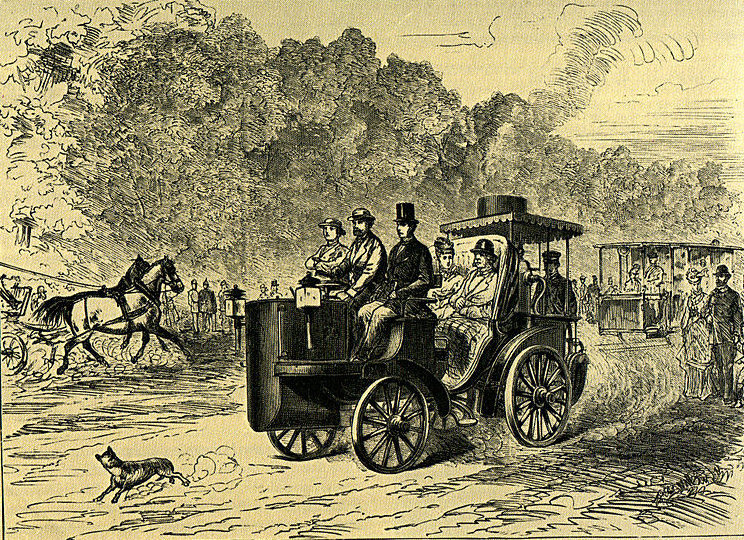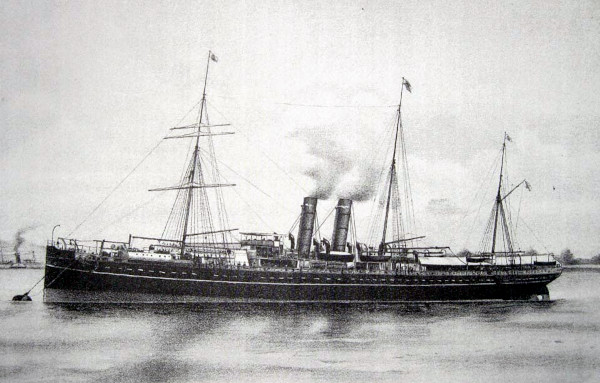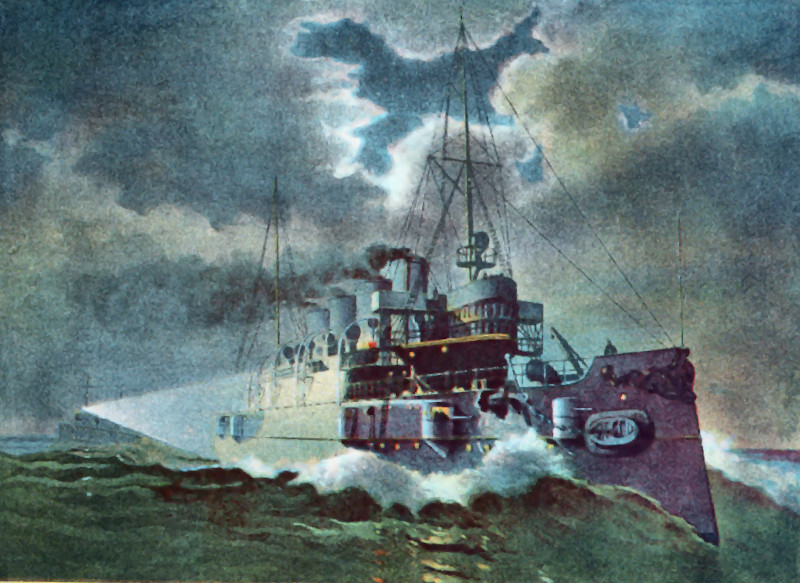From horse drawn carriages to thundering locomotives to soaring airships and aircruisers, there’s more than one way to get around in the World of Mythania.
Across the Land
Horses and horse drawn carriages remain the most common form of transportation today. Since the end of the War of Tyranny, which saw the first use of steam powered machines in warfare, vehicles driven by steam and ichor engines have become increasingly common. Locomotive trains join distance cities, while steamrails crisscross the urban labyrinth of the major industrial cities. Steam tractors and other mobile engines have proven themselves invaluable in both industry and agriculture. Motor-coaches can be found puttering along cobblestone streets and rural roads alike, while thundering juggernauts and landships bristling with cannons have changed the face of warfare forever.
Locomotives

Locomotives are massive steam-powered machines, capable of hauling enormous loads over considerable distances along tracks of rails. The term “locomotive” refers to the powered engine unit, which consist of the firebox, boiler, drive system, and wheels, behind which is attached a train of cars for cargo or passengers. Although steam engines are still the most common kind, steam turbines and ichor engines are also in use. There have also been a number of experiments with elemental turbine locomotives.
Steamrails are similar to locomotives, but are smaller and primarily used in cities. Although there are both cargo and passenger steamrails, in common vernacular, “steamrail” or “the rail” refers to passenger steamrails. Today, steamrail service exists in many large cities, most prominently in the clockwork city of Corradon, as well as Abridor, Oleion, and Falmore-Glave, and to a limited extent Duntara, Tareneth, Kadre, and Bar Hashad. Kalkhemed has an extensive steamrail system as well, perhaps rivaling that of Corradon.
Steam Carriages
The first steam carriage was demonstrated in Suddaea. Although the idea was at first herald as a great innovation, being loud, cumbersome, and sluggish, the “horseless carriages” did not immediately catch on. Nevertheless, inventors continued to dabble with steam carriages and coaches until the War of Tyranny. In the latter half of that war, the concept of steam coaches was developed into “armored steam battle wagon”, later termed juggernauts. In the years and decades of recovery after that terrible war, new developments in industry and engine production heralded the arrival of modern motor coaches and locomobiles.

Motor Coaches
Motor coaches and carriages are essentially the same as steam coaches and carriages, except they are driven either by alchemical ichor engines or compact aetheric motors, rather than steam engines. The first motor coaches were far more costly than steam carriages, but were more powerful and fuel efficient. Like steam carriages, motor coaches could hold two, four, or even six passengers, and were either fully enclosed, or had an open cab with the driver at the front or raised on a seat behind the passanger compartment. The best-known maker of both steam and motor coaches is Sterling Motors and Engineering.
Locomobiles

Locomobile is a generic term meaning a “vehicle that moves”, and which is obviously modeled word “locomotive.” Thus, any steam or motor coach can be called a “locomobile,” and indeed the word has recently begun to replace the older terminology. However, the term locomobile is more often applied to motor coaches that have abandoned the classic coach or carriage look in favor of a lower and more narrow profile. Such locomobiles have larger engines, lower ground clearance, rubber rimmed wheels, and a cockpit rather than a cab, which may or may not have a retractable roof. Most locomobiles are powered by ichor engines, but they can be powered by steam engines, steam turbines, vitriolic batteries, aetheric motors, or empowered elemental turbines.
Juggernauts
The first war machines that could properly be called juggernauts appeared during the War of Tyranny. These early juggernauts were called armored battle wagons or steam battle wagons, while larger ones were called landships. During the recovery period between the War of Tyranny and present conflict with the Grand Imperium, development of steam-powered war machines grew little. By the 1400s and early 1500s, the nations of the world began rearming as tensions brewed. Along with the rise of ironclad ships, dirigible men-of-war, aeronefs, and aircruisers, so too came the return of armored battle-wagons—now termed juggernauts.

Today, juggernauts are modeled after steam tractors with the addition of heavy armor plating and weaponry. Their massive wheels are reinforced with additional armor and may have spikes both for traction and intimidation. Their weapons general consist of one or two large cannons augmented by smaller side cannons, or guns mounted in sponsons. Juggernauts often mount the latest pneumatic and automatic guns, including grinder guns, rotor guns, turbine guns, or hiramers.
Over the Sea
Over the past century, naval ships have changed from wood and canvas ships-of-the-line, to ironclad steam-driven battleships. The vast majority of merchant ships are still wood and canvas, but steamers also have their place in private companies.
Ships of Sail
The first ships to set sail were constructed of wooden hulls with one or more masts carrying one or more sails to catch the wind. Such vessels ranged in size from small and fast cutters and windjammers to bulky galleons and caravels. These ships were once the mainstay of merchant trade, sea voyages, and exploration, and indeed remain quite common through the Medrean Sea and Sea of Isles.
Sail-powered warships include clippers, frigates, and great ships-of-the-line. These ships are often referred to by rating, as in first-rate ship, second-rate ship, etc., based on the number of guns and crew size. First-rate ships of the line were the great wood-and-canvas warships that once dominated the seas, armed with eighty to a hundred guns along their broadsides. Great ships are still in use today, primarily because of their long service life, but they have nevertheless been made obsolete by steamers, ironclads, and armored battleships.
Ships of Steam

Steam-powered ships saw their first widespread use during the War of Tyranny when when Darius lead their fleet of burgeoning new steam warships to victory at the climactic Battle of Sculdora. The centuries following the that terrible war saw advances and innovations the likes of which had not been seen since the legendary Age of Marada. By the 1400s, every harbor and port of call received as many steamers as they received traditional sailing ships. By 1500, steamers outnumbered those aging vessels of wood and canvas.
Steamers can be divided into two categories: side-wheel steamers and sternwheel steamers. Sidewheel steamers typically have two paddle wheels, located on either side, and may either be open or encased. Sternwheel steamers have a single wide paddle wheel in the rear. Both kinds may or may not have sailing masts in addition to their steam engines. Those with sailing masts typically deploy them in good weather and favorable winds to reduce fuel costs or keep the sails in reserve in the event of engine failure.
Frigates and Battleships
The first ironclads steamers were early wooden hull steamship, platted with riveted iron and steel armor, and armed with cannons and carronades, deployed during the latter half of the War of Tyranny. Ironclads continued to be developed through the century following the War of Tyranny, though they never outpaced or replaced ships-of-the-line.
But the mightiest warships of the present era are the great steam-powered armored frigates, also called ironclad frigates, battleships, or dreadnoughts. The first true armored frigate was Darius’s flagship, Freedom’s Triumph, the largest paddle wheel steamer of her day, retrofitted to serve in the War of Tyranny.

Today, these mighty warships are veritable fortresses at sea. They are similar in design and construction to the great steamers, and like all steamers either have twin sidewheels or a single large sternwheel. Although they have fewer guns than traditional ships-of-the-line, their greater speed and maneuverable outclasses even the greatest first-rate ships of old. The few battles between ironclad frigates and older ships-of-the-line are so disproportionate that some ironclad captains have refused to engage on the grounds that doing so would be tantamount to cold-blooded murder.
In the Air
For over two centuries, airship have been the quintessential hallmark of military and economic power for every industrialized nation.
Although dirigible airships are by far the most common type of aircraft, ornithopters, aeronefs, airdories, and enormous aircruisers can be seen powling the skies above.
Dirigible Airships
Airships are lighter-than-air craft held aloft by a voluminous envelop containing the highly rarefied alchemical gas known as cavenic lifting gas. Although not explosive, cavenic gas is flammable when ignited, and great safety precautions must be taken to avoid fire. Contrary to misconceptions, puncturing an envelop does not immediately deflate an airship, as the pressure inside and outside the envelop are the same.
Apart from blimps and balloons, the most common ship of the sky is the dirigible airship. The first true dirigibles (meaning “directable” or “steerable”) appeared during the War of Tyranny, and these vessels had a semi-rigid frame, allowing them to be larger and even armored, and were driven by steam-powered airscrews.
Newer rigid frame dirigibles are much larger, some measuring eighty hundred feet or more in length, and have cabins and compartments not only in their large gondola, but additional decks internal to its main body. These additional decks are usually just above the gondola decks, and may stretch to the back of the ship.
Today, dirigible airships cover many of the roles that older sailing ships once held, from passenger transport, mail delivery, shipping cargo, and numerous military roles.

Men-of-War
The term “man-of-war” is typically applied to armed and armored dirigibles used in direct combat roles (scout, recon, and transport dirigibles are not men-of-war, even if they are military ships). The term was original “man-of-war ship,” meaning “a ship that carries fighting men,” and was first applied to sailing vessels. But the word was eventually co-opted to described armed dirigibles.
With broadside cannons, turret guns, automatic guns, and an arsenal of bombs and rockets, these formidable ships can singlehandedly turn the tide of battle. Larger men-of-war dirigibles may carry one or two wings of aeronefs, totaling between 10 to 20 craft in all, ranging from light attack craft to large reconnaissance airboats and bombers.

Super Dirigibles
Super Dirigibles are those dirigibles and men-of-war that are of a class significantly larger than most. Super dirigibles can measure over fifteen hundred feet in length, and some have not one, but two massive envelop hulls attached side-by-side, or with a larger structure built in-between. Because of their size and the enormous amount of structural framework and armor plating, many super dirigibles have novarite alloyed metals in their hulls. Although this makes them considerably more costly, they are still not as expensive to construct as aircruisers (at least, in terms of relative size, mass, and crew complement).
Super dirigible warships are truly an impressive sights to behold. As warships, they dominate the sky, with only aircruisers rivaling their power. Bristling with long-range artillery, close-in defense guns, rockets, cannons, bombs, and aerial torpedoes, super dirigible warships can rain destruction across armies, fortresses, and cities alike.
Aircarriers are those super dirigibles outfitted with hangers and top-of-the-hull airstrips, ready to launch squadrons of aeronefs and ornithopters into the heat of battle.
Ornithopters
An ornithopter is a flying craft that derives its lift from the rapid movement of its wings, much like a bird, or more typically, an insect. The development of advanced clockworks, pneumatic actuators, and compact steam engines, lead to further refinements in ornithopter technology. Some were even powered by vizstones and aetheric motors, though at great expense. With the development of the ichor engine, ornithopters at last became affordable and practical.

Often simply called thopters, these craft typically have two or four large wings, powered by independent flywheel motors. They can fly forward, backwards, swoop left and right, go straight up and down, and even hover in place. They are slower than aeronefs, and are also much more expensive due to complex mechanics, as well as being prone to breakdown. Their only advantage over aeronefs is their ability to take off vertically and hover—which is a significant advantage to be sure.
Ornithopters can be found ranging from small, one-man craft to larger transport thopters capable of carrying cargo or dozens of personnel.
Aeronefs
Aeronefs are heavier-than-air craft that derive most of the lift from airfoil wings, powered engines, and, to some extent, novarite. The majority of aeronefs are used for recon, as well as for escorting airships. Modern aeronefs are typically either monoplanes or biplanes, with biplanes having the advantage of lower stall speed, while monoplanes are generally faster and more maneuverable. Most are propelled by a single rear-mounted engine, but a few have duel wing-mounted engines. The cockpit is typically near the front, and newer models have an enclosing canopy of glass or armored tektite.

Medium and heavy aeronefs constitute a class of aeronef somewhere between an aeronef and larger airdories. Many still follow a biplane design, and may have a boat-shaped hull, allowing them to land and take off on water, for which reason they sometimes called airboats or flying boats. There is some dispute as to what distinguishes a heavy aeronef from a true airdory, but airdories tend to be more ship-like in build and function, and, like aircruisers, incorporate more novarite to offset their weight.
Airdories and Airclippers
The term airdory is a back-formed designation for very large aeronefs, molded on the terms used to distinguish aircruisiers and airclippers. Airdories are essentially the same as heavy aeronefs, though the term is typically reserved for aeronefs at the heavier end of the scale. Airdories typically have more interior space, crew bunks, and sometimes multiple cabins. They are often crewed by 10 to 20 men, but are still controlled from a large cockpit rather than a bridge. Novarite typically offsets only 40% of their overall mass, which allows them to have smaller wings (if any) and a lower stall speed. Many airdories are capably of near-vertical landing and takeoff and may have landing struts instead of landing gear.
Airclippers are basically small aircruisers, or very large airdories, but are different enough from both to warrant their own classification. Airclippers typically weigh around 600 to 1000 tons, but the designation can apply to ships not quite big enough to be considered true aircruisers. In general, airclippers have two or three internal decks and an upper or forward bridge. They are usually crewed by 30 to 40 men, and can have dozens of gun ports and gun turrets. Like aircruisers, much of their mass is offset by novarite, but they still require significant engine power to stay aloft.
Aircruisers
Aircruisers are true fortresses of the air, the undisputed kings of the sky, mounting naval cannons along their broadsides and turrets, drop bombs, aerial torpedoes, and automatic guns such as rotor guns, turbine guns, or hiramers. The largest aircruisers also carry aeronefs within their internal launch hangers.
Aircruisers are superficially similar to great flying ironclad warships, with a dozen or more massive ichor engines or aetheric impellers mounted along the hull. Aircruisers can have anywhere from 4 to 5 decks, plus a smaller bridge, complete with crew bunks, galleys, an engine room, a chart room, a wardroom, and even VIP staterooms. But unlike dirigibles, which stay aloft using lifting cavinc gases, aircruisers are lightened using costly novarite alloys.

Airfrigates are a class of ship smaller than an aircruisers, but significantly larger than an airclipper. These “near-aircruisers” are lighter armed, have less armor, and typically serve an escorts to aircruisers.
Conversely, the largest aircruisers are sometimes referred to as super-aircruisers, airbattleships, or airdreadnaughts. To say they are simply larger aircruisers is a bit of a disservice, as they are undoubtedly the largest and most powerful aerial warship constructed in the modern day. Like aircruisers, they are similar to flying ironclad battleships, with conning superstructure, turret guns, aerial torpedoes, and aeronef launch hangers.
Eldren Windriggers
Eldren windriggers are more akin to traditional sailing ships than they are to aircruisers, airclippers, or even dirigibles. Instead of using lifting gas or novarite, Eldren windriggers rely on the empowerments of specially trained Eldren elementors called windguides, who summon and control a great vortex of air currents directly behind the ship to propel the craft upward and forward. Most windriggers have the general appearance of a sloop, clippership, or galleon, but instead of two or three masts standing atop the main deck, they have a single mast standing atop the main deck with the additional of a mast and sailing rig to the port and starboard as well. This tri-rigged sail configuration allows the craft to maneuver in three dimensions, sailing upward and downward, as well as turning to port and starboard.
Eldren windriggers are not as heavily armed or armored as aircruisers or dirigible men-of-war, but their windguides are able to conjure powerful defenseive and offense empowerments. In addition, windrigger warships are equipped with empowered weaponry as well.